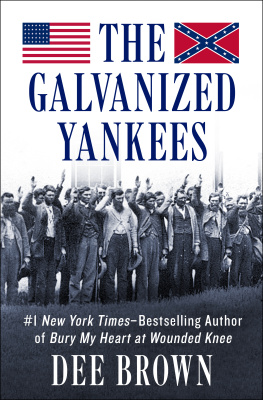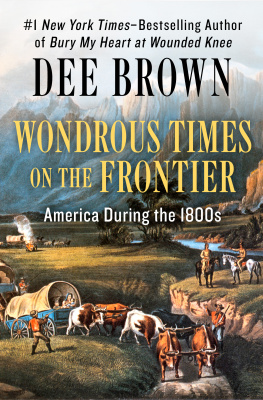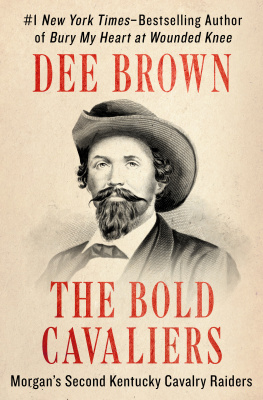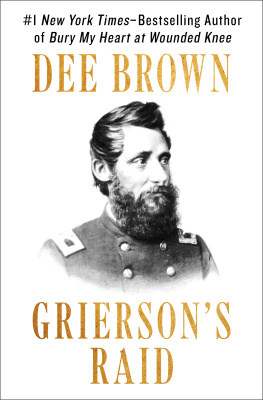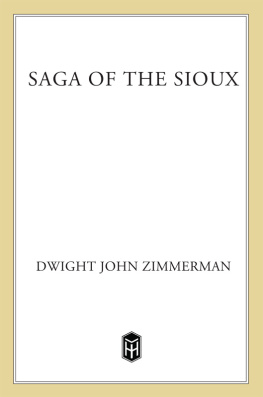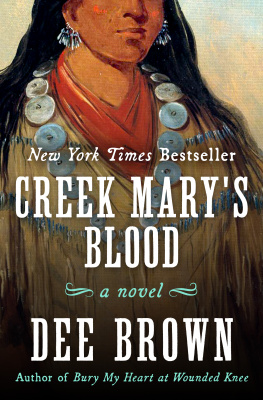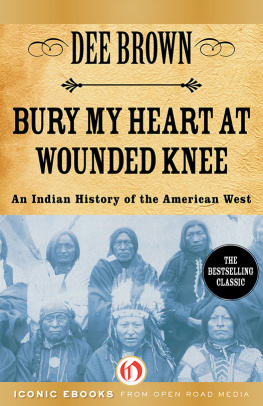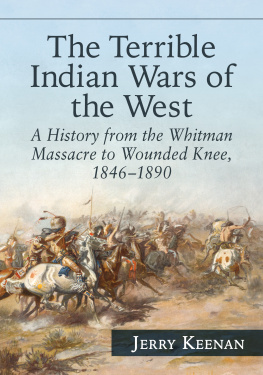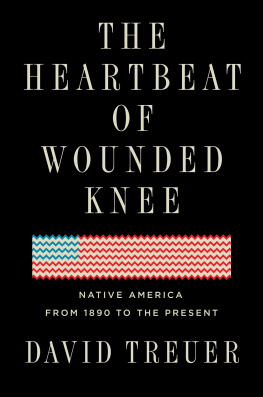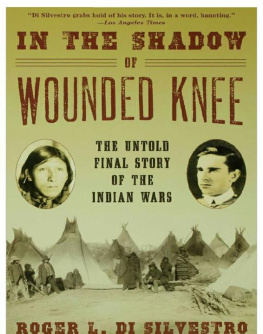Dee Brown - Bury My Heart at Wounded Knee: An Indian History of the American West
Here you can read online Dee Brown - Bury My Heart at Wounded Knee: An Indian History of the American West full text of the book (entire story) in english for free. Download pdf and epub, get meaning, cover and reviews about this ebook. year: 2012, publisher: Open Road Media, genre: Politics. Description of the work, (preface) as well as reviews are available. Best literature library LitArk.com created for fans of good reading and offers a wide selection of genres:
Romance novel
Science fiction
Adventure
Detective
Science
History
Home and family
Prose
Art
Politics
Computer
Non-fiction
Religion
Business
Children
Humor
Choose a favorite category and find really read worthwhile books. Enjoy immersion in the world of imagination, feel the emotions of the characters or learn something new for yourself, make an fascinating discovery.

Bury My Heart at Wounded Knee: An Indian History of the American West: summary, description and annotation
We offer to read an annotation, description, summary or preface (depends on what the author of the book "Bury My Heart at Wounded Knee: An Indian History of the American West" wrote himself). If you haven't found the necessary information about the book — write in the comments, we will try to find it.
Bury My Heart at Wounded Knee: An Indian History of the American West — read online for free the complete book (whole text) full work
Below is the text of the book, divided by pages. System saving the place of the last page read, allows you to conveniently read the book "Bury My Heart at Wounded Knee: An Indian History of the American West" online for free, without having to search again every time where you left off. Put a bookmark, and you can go to the page where you finished reading at any time.
Font size:
Interval:
Bookmark:






For Nicolas Brave Wolf
Chapter Two
Chapter Three
Chapter Four
Chapter Five
Chapter Six
Chapter Seven
Chapter Eight
Chapter Nine
Chapter Ten
Chapter Eleven
Chapter Twelve
Chapter Thirteen
Chapter Fourteen
Chapter Fifteen
Chapter Sixteen
Chapter Seventeen
Chapter Eighteen
Chapter Nineteen
AN ANCIENT TRADITION TELLS us that the interval between the birth of the parents and the arrival of their first offspring averages thirty years. We call that a generation. Thirty years ago, early in 1971, this book was born. And so now it is beginning its second generation.
As the first generation ends, it is almost a clich to say that enormous changes have occurred during the time that has passed. Yet vast changes certainly have affected the present-day descendants of the old tribal prophets whose stories are told in these pages.
During the past generation, some tribal reservations have prospered, others have not. There are now, and probably always will be, disagreements within tribes as to the direction their people should take. In spite of the many personal frustrations and difficulties young seekers of knowledge experience, it is no longer unusual to meet American-Indian lawyers, physicians, college professors, computer specialists, artists, writers, or members of almost any other profession or trade. Yet on some reservations there is still a shortage of proper places in which to live. And the county with the deepest poverty in the United States is still a tribal reservation.
Judging from letters I have received through the years, the readers who have given life to this book come from almost all the hundred or so ethnic groups that comprise this unique and awesome place called America. Small though the comparative number of American Indians is, almost all other Americans seem to have an earnest fascination for their history, their arts and literature, their attitude toward the natural world, and their philosophy of human existence.
And this wide interest exists beyond the borders of America into the lands of other people and other cultures. Name a small nation, one whose people have a history of past injustices and oppression, and this book will likely be in print there.
We rarely know the full power of words, in print or spoken. It is my hope that time has not dulled the words herein and that they will continue through the coming generation to be as true and direct as I originally meant them to be.
DEE BROWN
in the year 2000
SINCE THE EXPLORATORY JOURNEY of Lewis and Clark to the Pacific Coast early in the nineteenth century, the number of published accounts describing the opening of the American West has risen into the thousands. The greatest concentration of recorded experience and observation came out of the thirty-year span between 1860 and 1890the period covered by this book. It was an incredible era of violence, greed, audacity, sentimentality, undirected exuberance, and an almost reverential attitude toward the ideal of personal freedom for those who already had it.
During that time the culture and civilization of the American Indian was destroyed, and out of that time came virtually all the great myths of the American Westtales of fur traders, mountain men, steamboat pilots, goldseekers, gamblers, gunmen, cavalrymen, cowboys, harlots, missionaries, schoolmarms, and homesteaders. Only occasionally was the voice of an Indian heard, and then more often than not it was recorded by the pen of a white man. The Indian was the dark menace of the myths, and even if he had known how to write in English, where would he have found a printer or a publisher?
Yet they are not all lost, those Indian voices of the past. A few authentic accounts of American western history were recorded by Indians either in pictographs or in translated English, and some managed to get published in obscure journals, pamphlets, or books of small circulation. In the late nineteenth century, when the white mans curiosity about Indian survivors of the wars reached a high point, enterprising newspaper reporters frequently interviewed warriors and chiefs and gave them an opportunity to express their opinions on what was happening in the West. The quality of these interviews varied greatly, depending upon the abilities of the interpreters, or upon the inclination of the Indians to speak freely. Some feared reprisals for telling the truth, while others delighted in hoaxing reporters with tall tales and shaggy-dog stories. Contemporary newspaper statements by Indians must therefore be read with skepticism, although some of them are masterpieces of irony and others burn with outbursts of poetic fury.
Among the richest sources of first-person statements by Indians are the records of treaty councils and other formal meetings with civilian and military representatives of the United States government. Isaac Pitmans new stenographic system was coming into vogue during the second half of the nineteenth century, and when Indians spoke in council a recording clerk sat beside the official interpreter.
Even when the meetings were in remote parts of the West, someone usually was available to write down the speeches, and because of the slowness of the translation process, much of what was said could be recorded in longhand. Interpreters quite often were half-bloods who knew spoken languages but seldom could read or write. Like most oral peoples they and the Indians depended upon imagery to express their thoughts, so that the English translations were filled with graphic similes and metaphors of the natural world. If an eloquent Indian had a poor interpreter, his words might be transformed to flat prose, but a good interpreter could make a poor speaker sound poetic.
Most Indian leaders spoke freely and candidly in councils with white officials, and as they became more sophisticated in such matters during the 1870s and 1880s, they demanded the right to choose their own interpreters and recorders. In this latter period, all members of the tribes were free to speak, and some of the older men chose such opportunities to recount events they had witnessed in the past, or to sum up the histories of their peoples. Although the Indians who lived through this doom period of their civilization have vanished from the earth, millions of their words are preserved in official records. Many of the more important council proceedings were published in government documents and reports.
Next pageFont size:
Interval:
Bookmark:
Similar books «Bury My Heart at Wounded Knee: An Indian History of the American West»
Look at similar books to Bury My Heart at Wounded Knee: An Indian History of the American West. We have selected literature similar in name and meaning in the hope of providing readers with more options to find new, interesting, not yet read works.
Discussion, reviews of the book Bury My Heart at Wounded Knee: An Indian History of the American West and just readers' own opinions. Leave your comments, write what you think about the work, its meaning or the main characters. Specify what exactly you liked and what you didn't like, and why you think so.

